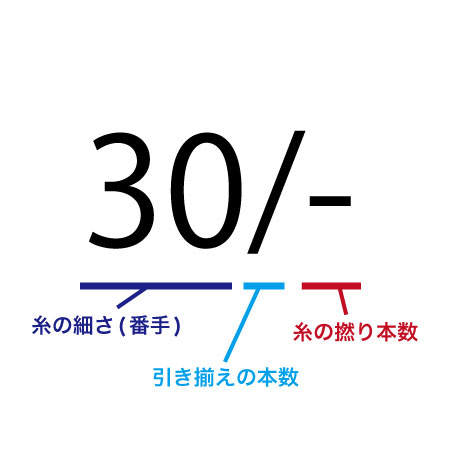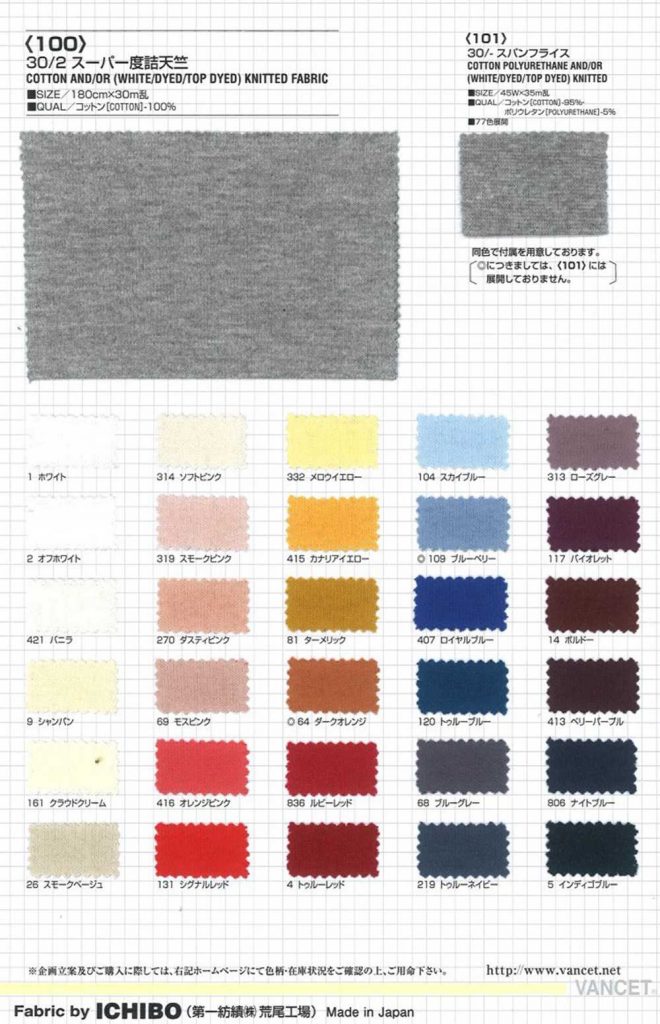Cut and sew fabric explanation: What does “30/-” mean?
When it comes to cut and sew, most of us are familiar with jersey knit fabric. But what do those numbers on the fabric mean? Let’s find out the notation of fabric yarn together!

Yarns’ Notations
For cut and sewn fabrics, the following notations are often used
30/-
30/2
16//s
If you know what these notations mean, you will be able to guess what kind of fabric it is from the name of the item.
30/-
Let take 30/- as an example. The first number 30 means 30 count, and the larger the number, the finer the yarn.
The next slash is the number of skeins. Alignment means that when knitting yarn, multiple yarns are pulled together without twisting, and are then hooked together as if they were a single thread.
If there is one slash, it means knitting with a single thread. Two slashes mean that two yarns are pulled together and knitted like a single yarn.
The hyphen at the end indicates the number of twisted yarns, which is the number of single yarns.
In the case of single yarns, letters such as hyphen, s, and 1 are used.
In other words, 30/-, 30/s, and 30/1 all mean the same thing.

Once you have this down, you will be able to imagine to some extent what the characteristics of the cut-and-sew fabric are by the name of the item.
Fabric name description

For example, this product is described as 30/2, so you can see that it uses 30 count twin yarn.
Simply put, 30 count twin yarn means that the thickness of the yarn is double that of a 16 count single yarn.
From this, we can see that this fabric is moderately thick, but because twin yarns are used, the fabric seems to have a little bounce to it.
Furthermore, it is described as “Super Double,” which means that it is a material with a high density of knitting that is difficult to see through.
Ounce
T-shirts are often labeled as XX ounce T-shirts.
The meaning of the ounce label on a T-shirt refers to the weight per square yard of fabric.
One square yard is 90cm square, and one ounce is about 28g.
In other words, a 5oz T-shirt weighs about 140g/m2.
There is no exact correlation between the ounce and the yarn used in the cut and sewn garment.
What this means is that even if a 30 count single yarn is used, the weight of the fabric will vary depending on the density of the knitted fabric.
So, the comparison between a fabric using 40 count twin yarn and a fabric using 30 count single yarn is not a strict comparison of fabric weights.
Conclusion
Fabric description of cut and sewn introduced this time is just a basic information. It is important to communicate with the fabric manufacturers to make sure there is misunderstanding.
For example, if you want to make a fabric with a 30 count three-count yarn, it is better to say 30/- three-count yarn than to say 30/3, because it is more difficult to make a mistake.
Similarly, if you want to make a 3-ply fabric with 30 count single yarn, it is easier for the fabric manufacturer or miller to understand if you say “30/- 3-ply” rather than “30/-/-“.
The notation of cut and sewn fabrics is not strictly standardized, so it would be better to use the notation introduced here on a case-by-case basis.
For more cut and sewn fabric, please visit our Jersey product list .



